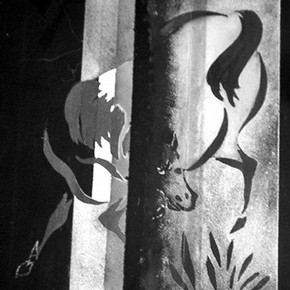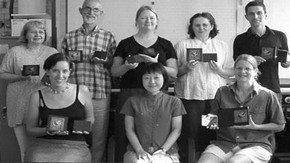Conservation Journal
Summer 2004 Issue 47
Traditional Japanese lacquer workshop: Summer 2003
The V&A Conservation Department has held a series of traditional Japanese lacquer workshops taught by lacquer artists visiting the UK for twelve months, under the Japanese Government Overseas Study Programme for Artists. The workshops aim to develop and deepen understanding of the traditional materials and technology used to create and decorate oriental lacquer. Participants have included conservators, curators and interns from the V&A and other museums as well as RCA/V&A MA conservation students. The craft of urushi is not taught in the West and it is therefore a privilege to be able to experience the use of these materials first hand.
The first workshop was held in 2001 and was taught by Natsuki Kurimoto, who covered the Kyoto method of making foundation layers, and decorative techniques such as raden (mother of pearl), kanshitsufun makie (sprinkling dried coloured lacquer powder) and makie (sprinkling of gold powders). Kiyomi Okukubo led the 2004 workshop and focussed on the kanshitsu (dry lacquer) method used to create three dimensional objects such as Buddhist statues, the Wajima method of making foundation layers (honkataji sample board) and decorative techniques such as kirigai (cutting thin shell) and togidashi makie (in which the design is coated with urushi, dried, and then the surface carefully polished to reveal the design).
In 2003, Yukiko Kashihara, a contemporary lacquer artist based in Wajima, Japan, taught the decorative techniques of togikiri (decoration with fine metal powders) and kawari-nuri, an impasto technique.
The workshop was held over ten afternoons between 4 June and 4 August. For one session Yukiko was joined by Yuko Sakurai, who demonstrated the art of chinkin or incised lacquer and helped participants to try out this technique.
The initial session started with careful explanation of the health and safety aspects of working with urushi (raw lacquer), which is botanically related to the poison ivy plant. Urushi can cause an allergic rash and dermatitis when liquid but becomes inert once it has fully dried. Drying requires a relative humidity of 60-80% and often utilises a humidification box (furo).

Figure 2. Process board for togikiri technique. Photography by Yukiko Kashihara (click image for larger version)
Yukiko presented her students with ready-prepared black lacquer tablets, allowing us to by-pass the laborious and careful processes necessary to produce a fine, flat lacquer surface. The initial process (togi) was the careful and even abrading of the surface of the ground lacquer, using the end grain surface of small blocks of charcoal from the Pawlonia tree, and lubricated with water. For okime or design transfer, the design is traced onto Japanese paper with e-urushi (urushi coloured with red iron oxide pigment or bengara). We used titanium white pigment (a modern variation on the traditional technique) sprinkled onto the wet e-urushi to create the outline of our design.
We worked from the darkest area of our design, using rose-urushi (a mixture of roiro-urushi - the black urushi used for coating - with ki-urushi, unrefined or raw urushi) as a base on which to sprinkle powdered charcoal (sumiko). The next step repeated the process for the medium tone areas, using a mixture of sumiko and gin-pun (silver powder). The lightest areas were painted with rose-urushi and sprinkled with gin-pun alone. The powder was consolidated with rose-urushi and then completely covered with a thin coat of roiro (black) urushi. The tablets were placed into the furo to cure between each successive stage.
At this stage the design was almost invisible. It was revealed in the togidashi process, when the surface was abraded once more with charcoal. At this stage it was all too easy to abrade through the decoration into the background layers. The next stage was to polish the surface (dozuri) with a fine commercial abrasive paste. This was followed by rubbing ki-urushi on to the surface to fill any slight faults, a process known as suri-urushi. The final high gloss surface was achieved by polishing with vegetable oil and tsuya-age-ko (polishing powder).
The second decorative technique that Yukiko taught us was kawari-nuri lacquer in seikaiha or wave pattern. The urushi was mixed with tofu to create a thick, sticky mixture that was used to create a low relief wave pattern. With this technique it is vital that the first layer is not too thick or else the surface may harden faster than the under-layer, to produce chinko-urushi (wrinkled urushi) and shame for the maker. Once cured a second, contrasting colour was added over the whole surface (nurikomi). When the surface was abraded it revealed a polychrome wave pattern. The surface was then finely polished with a commercial polishing paste and then rubbed over with thin urushi (ki-urushi) to fill any minor faults. The final stage involved polishing with vegetable oil and tsuya-age-ko (polishing powder).
Handmade tools and brushes, which Yukiko had brought over from Japan, were used for each process. Bamboo tubes with different grades of mesh over the end were used to sprinkle the different sizes of powders. The brushes were a pleasure to handle although some participants were shocked to discover that some were made from cat hair. Rat hair and human hair are also used. The care of these brushes was an art in itself, requiring preparation before use and thorough cleaning at the end of the day.
After Yukiko's skilled demonstrations of the techniques involved, we were grateful for her charitable reception of our often ham-fisted efforts. Poor practitioners we might have been, but we had certainly learned a huge respect for the skill involved in the creation of lacquer decoration.
The V&A is very grateful to Natsuki Kurimoto, Yukiko Kashihara and Kiyomi Okukubo for their generosity in sharing their expertise and knowledge with us, and to Shayne Rivers and Shiho Sasaki (2001) for organising the courses.
Summer 2004 Issue 47
- Editorial
- Conservation Department away day - December 2003
- Future challenges for RCA/V&A conservation
- RCA/V&A Conservation - do professional conservators make a contribution?
- Traditional Japanese lacquer workshop: Summer 2003
- The Internship and Placement Programme at the V&A Conservation Department
- LightCheck®: A new tool in preventive conservation
- RCA/V&A Conservation study trip, March 2004: Lisbon, Portugal
- Printer friendly version
